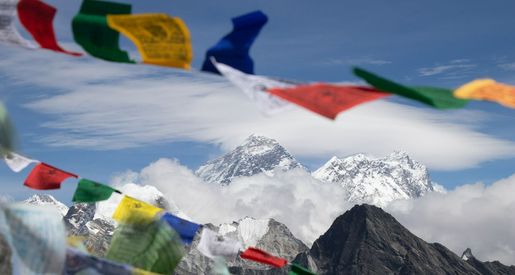- Details
- Category: Knowledge Centre
Training for Everest Base Camp
A fantastic write up and insight from one of our awesome EverTrekker's and High Altitude Personal Trainer Adam Gawley about his journey to Everest Base Camp. Adam has worked in the fitness industry for a number of years and has trained many high altitude mountaineers with huge success. He certainly knows a thing or two about how to prepare for the extreme high altitude & here he goes into great detail on the workouts he recommends for getting your body in the best physical condition for any high altitude trek especially, Everest Base Camp.
After travelling through Nepal, Sri Lanka and India, I’ve finally had time to reflect on our recent trip into the Himalayas for our trek to EBC. Everyone who embarks on this almost two-week hike does so for different reasons. For myself, it was a chance to see Mt Everest, the mountain I hope to summit one day and for my girlfriend Sarah it was a huge bucket list item in itself that coincided with our travels through India.
Although it is absolutely possible to get to Everest Base Camp without a guide, we opted to join a twelve person group led by Andy Moore, the “Head Yeti” of EverTrek based out of the UK.
It ended up being the right decision as everything was arranged for us including the rigamarole of entering and exiting the National Parks, food and accommodation, porters, and most importantly for me, the nightmare that is Lukla and Kathmandu airports. Along with Andy, our head Nepalese guides were Dawa Tashi Sherpa, a two time Everest summiteer, his father, the invincible 57-year-old Gelzeng Sherpa who has guided over 30 ascents of Island Peak, 20+ on Mera Peak plus numerous other peaks in the Himalayas & Pasang Sherpa as an additional guide. Their leadership proved to be an invaluable resource especially for the people in our group that struggled, of which there were many. Nine of our twelve suffered from some form of altitude issues along the way, one so bad she was forced to turn back midway through. Of our group only myself, Sarah and Mandy, an ex-military woman, remained unaffected by the rigours of the journey to Base Camp demanded.
The trek is 11 days long, eight up and three down with an additional night spent at Lukla so 12 days spent in the mountains.
Over 320,000 on the step counter, 124 kilometres, over 5000m altitude and temperatures well below zero. It’s a significant hike which requires the right training. People of all different fitness levels make it to Base Camp, and the EverTrek crew have a great track record of successful completions, but the fitter and more ready you are, the more enjoyable the trek becomes.
Here's a short clip of Adam en route to Everest discussing the training and fitness involved.
My training began about a month before we flew out. Having just finished a Spartan race and with a background in everything from CrossFit to powerlifting to bouldering, I was starting out with a pretty solid base. A lot of my training focused on building my leg endurance and stepping strength. One of the biggest difficulties with such a high altitude climb are the large rocky steps that skyrocket your heart rate and have you breathing hard after only a minute or two of work.
This starts happening after about 4000-4500m altitude and, aside from living at those heights, it’s not something you can really prepare for. However, building the required leg strength makes each of these steps a lot easier and has you moving much more efficiently. Other trekkers who would be keeping pace with me on the flat sections would quickly fall behind as soon as the climbs began again.
My favourite movement for gaining this unilateral leg strength was kettlebell front rack walking lunges. I performed sets of these twice a week starting with two sixteen kilogram bells at 5 sets of ten steps and progressing through the weeks to two twenty kilo bells for 5 sets of 20 steps. I upped my steps with the sixteen-kilo bells every session until reaching 20, then I progressed to the twenty-kilo bells and started again at ten steps adding steps until I reached 20.
Standard linear progression took my workouts total weight from 1600 kilos to 4000 kilos. That’s a significant increase over the course of four weeks. It’s also important to note that the first few sessions were very manageable which gave me a better opportunity for improvement at the end of the training cycle. If I had started with an extremely difficult session and pushed my reps to failure it’s likely I wouldn’t have been able to increase the total load week after week, resulting in burnout, decreased final weight and a diminished overall amount of work completed.
Although we had porters carrying the bulk of our equipment, each of us carried a day pack weighing between 5-10 kilograms. Not a great burden, especially considering we saw a porter carting a refrigerator on his back (seriously!!), but it’s definitely something that makes a difference. By choosing a front rack kettlebell position I overcompensated for the load which made the backpack weight almost unnoticeable during the hike.
This movement was not the only one in my training session. I began the workout with skipping as a general warm up and followed it with hip and lower body activation and mobility drills.
After the warm up I would start my main workout with pistol squats which I would do alternating reps for 5 sets of ten reps. I progressed these over the weeks by gaining in speed that it took to complete the total reps, decreasing rest time between sets and the efficiency of the reps themselves. The skipping as a warmup was chosen because it raises the body temperature sufficiently and allows my calves to get more consistent work, which, combined with my running on other days, added up to make my lower legs a complete non-factor in regards to fatigue on the trek.
After the single leg squats came the lunges and then I would superset front rack kettlebell squats with high rep kettlebell swings for added lower body work, supersetting them to make me breathe hard and work my anaerobic system. This was important for short uphill bursts to overtake sections of slower climbers. During peak season there are hundreds of people on the trail so these short bursts are paramount to keeping momentum and a decent pace.
I would finish my session with Poliquin step ups and single leg cross body deadlifts to bulletproof my lower body. Somewhat surprisingly, the downhill sections of the trek are what a lot of people struggle with the most. The steps down are havoc on the knees and, especially in a state of fatigue, the fast drops onto loose stone can result in quick adjustments at the least and injuries at the worst. Poliquin step ups are one of the best movements for strengthening the VMO(Vastus Medialis Oblique) and stabilising the knee joint and single leg cross body deadlifts do the equivalent for the hips.
This was my lower body strength session twice a week and I was very happy with the results. I would combine this with my regular upper body workouts, push and pull twice a week, running every second day of short to medium distances, stair runs and weekend hikes. One of the days that I couldn’t get out and hike I did a thousand step ups as a substitute.
As you can see I took my training seriously as should everyone considering this trek.
The Everest Base Camp trek was also a great excuse to buy new hiking boots, Salomons (I can’t recommend them enough), which needed to be worn in. The first time I wore them I walked about a kilometre on an easy trail. They proved to be extremely comfortable and I had no hot spots threatening blisters so the next test was a four hour hike in the blue mountains with solid incline and decline sections, decked out with the backpack I would be taking with me. Again the boots passed with flying colours so the only other time I wore them was on a day in Kathmandu after arriving when Sarah and I went exploring the city for about seven or eight hours.
As well as my boots I decided to wear in my hiking clothes I would be wearing during the trek. I did this because of a tip from a mountaineer I trained back in Sydney. He told me that when you’re walking for eight hours at a stretch you want your clothes as comfortable as possible, so new kit needed to be tested for any annoying niggles or mobility issues.
Having shelled out on an excellent backpack and worn in all my gear I felt confident I would have no equipment issues hindering my enjoyment of the trek. Combined with my weeks of training, and, in addition to choosing guides with a proven track record, I knew I had done everything I needed to do before I left for Nepal.
Previous Articles
- How to Train for the Everest Base Camp Trek
- How high is Everest Base Camp?
- How much spending money do you need for the Everest Base Camp trek
- What's the accommodation like on an Everest Base Camp trek
- Are showers available on the Everest Base Camp trek?
- What type of toilets are available on an Everest Base Camp Trek






